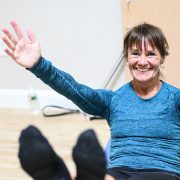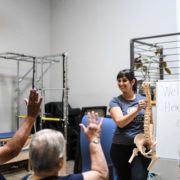Why Proper Breathing is Essential for Good Core Strength
When I’m working with clients, one of the most common things I see when someone is having trouble engaging their core is that they tend to hold their breath.
Why is this important?
Because breathing properly allows you to activate your deep core – and good activation of your deep core is essential if you want the rest of your core muscles to work properly and help you prevent things like back pain.
Let me explain…
Your “deep core” is made up of your diaphragm, pelvic floor, transversus abdominus (deepest layer of abdominals) and your multifidi (deepest layer of back muscles). These four muscle groups work together to make up your deep, inner core. If your deep core doesn’t function properly – your outer core muscles (abdominals, glutes, hip and back muscles) won’t have the support they need to work well. This can all lead to inefficient and compensatory movement patterns over time, and contribute to something like back or neck pain.
Your diaphragm controls how well and how deeply you breathe. When working properly, your deep core acts like a piston system, driven by your diaphragm. Upon inhalation, your diaphragm expands, causing your pelvic floor to lengthen and drop. When you exhale, your diaphragm contracts and your pelvic floor lifts like an elevator – all acting like a piston system moving down and up.
Additionally, the pressure created by this system also acts a bit like a balloon. Breathing in expands your pelvic floor and abdominal muscles out, stretching like a balloon would. Exhaling releases the air and allows your abdominals and pelvic floor muscles to contract, like the natural recoil that would occur if you let the air out of a balloon.
So, if this is a natural process, why do so many of us have problems activating our core properly?
It’s because as we age, and allow poor movement and posture habits to form, we “forget” how to breathe normally and most of the time aren’t even aware this is happening.
Here are some of the most common things I see with clients suffering from neck and back pain, and who aren’t activating their deep core properly:
1. Chest breathing
I see a lot of people breathing deeply but the only thing moving is their chest. Instead of their ribs expanding out and back, all you see is their upper chest moving out and up. This is very common, and it happens because your diaphragm isn’t expanding fully and thus, not pushing air down into your belly. Chest breathing often contributes to tight and elevated shoulders, back pain, and even tight hip flexors – because the deep abdominals can’t kick in properly, causing the rest of your body to compensate. Next time you want to take a deep breath, place one hand on your belly and make sure that it’s moving out and in along with your chest. That’s a first step to learning how to breathe properly so that your deep core can activate!
2. Your neck feels tight
Although back pain is often what’s associated with a “weak core”, people can also suffer from neck pain when they lack proper core activation. When people first start working with us for Pilates, a big complaint is they feel tightness in their necks when they are first learning how to activate their core and do a proper chest lift. The fascia (web like substance that holds and surrounds your muscles) of your deep core is connected to the deep fascia of your neck. If you’re not breathing properly and your deep core can’t activate, your neck may try and help out because it’s partly “connected”. We even see neck tightness like this in our experienced Pilates goers – and it’s a clear sign they’ve lost connection to their deep core or perhaps simply lost connection to their breath. Next time you’re doing abdominal work, check in with your neck and see if it feels tense. If so, it could be a sign you’re not fully activating your deep core. Improving how you breathe during abdominal work could help.
3. You hold your breath when you exercise
Did you know your diaphragm is a muscle? When you hold your breath, you’re contracting that muscle. For a muscle to work properly it needs to contract AND relax. If you hold your breath during exercise, it’s impossible for your diaphragm to expand (relax) and push air into your abdominals and activate that piston system we talked about earlier. In other words, your pelvic floor and deep abdominal stabilizers don’t have an opportunity to activate properly when you hold your breath. Without activation of your deep core, the rest of your body is going to have to compensate somehow. And this can set you up for unnecessary aches and pains, or worse, injury. I always say to my clients, “when in doubt, just keep breathing”. Because if you’re actively breathing, you at least have a shot at activating your deep core properly, even if you’re not 100% sure how to do it.
If you have trouble “feeling your abs” when you exercise, your neck and shoulders tense up when you work out, or your back and neck always hurt every time you work your core – it’s a sign you might not be activating your deep core very well.
Remember that good core strength starts with your breath!
Next time you work out, especially core-focused work, pay attention to the way you’re breathing. If you still have trouble, or you’re noticing back or neck pain, then reach out for a FREE Discovery Session or check out our Pilates offerings.










